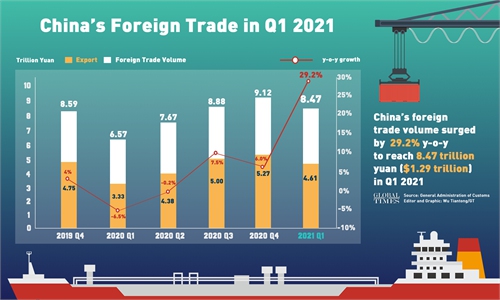
A Yemeni trader selects teapots while communicating with his Saudi Arabian client via video link at the Yiwu International Trade Market in Yiwu city of east China's Zhejiang Province, Jan. 14, 2021. (Xinhua/Huang Zongzhi)
All of China's provincial-level areas, except for Northeast China's Jilin and Southwest China's Tibet Autonomous Region, which have yet to report their figures, recorded double-digit GDP growth in the first quarter, according to statistics released as of Tuesday.
The robust growth rates across the country further underscored a full-fledged recovery for the Chinese economy from the COVID-19 pandemic, with most industries returning to or exceeding pre-pandemic levels. However, the growth pace may slow to normal levels in the second half of the year, an economist warned.
Among the 29 provinces, autonomous regions and municipalities that have released their growth figures, eight provinces recorded growth above the national average of 18.3 percent, led by Central China's Hubei Province, the province hit hardest by the COVID-19 virus in 2020. Hubei's GDP grew nearly 60 percent in the quarter. https://www.globaltimes.cn/page/202104/1221413.shtml)
Based on a two-year average, South China's Hainan Province was first with a 7-percent growth, followed by Southwest China's Guizhou Province, and East China's Jiangxi and Jiangsu provinces. According to published statistics, Hainan's growth was driven by new services and retail sectors.
The double-digit growth rates are mostly due to an extremely low base last year, when the country was bracing the full impact of COVID-19, according to Tian Yun, vice director of the Beijing Economic Operation Association.
With the effective containment of the outbreak, conditions in many industries, including manufacturing, retailing and catering, have returned to levels that are near to or exceed pre-pandemic figures.
"In the first quarter, there was a fast recovery not only on the supply side, but also in domestic demand, driving up manufacturing as well as retailing and catering," Tian said.
In Jiangsu Province, whose manufacturing sector accounts for one-seventh of the national total, the added value in industries above designated level rose by 33.6 percent year-on-year, with an average of 11 percent in the past two years. Seven out of the top 10 industries recorded growth of more than 25 percent.
In South China's Guangdong, where retailing activities are concentrated, the contribution of wholesale, retailing, lodging and catering to local GDP growth rose by 51.3 percent compared to last year.
In addition, foreign trade in several provinces drove accelerated economic growth in the first quarter. In Hubei, foreign trade spiked 88.1 percent to 117.46 billion yuan ($18.11 billion). Shandong's foreign trade grew by almost 39 percent, and Guangdong's bonded imports and exports grew by 27.8 percent.
However, Tian warned that growth might peak in the first half of this year and then gradually slow from the third quarter, as domestic and overseas demand stabilizes.
Global Times


